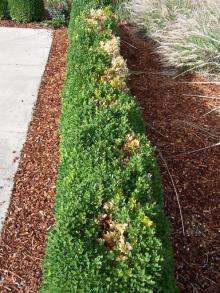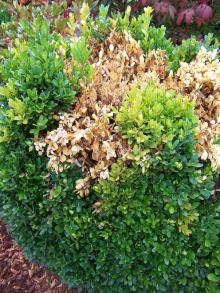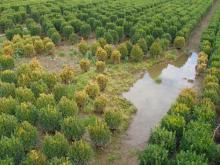Cause Phytophthora cinnamomi and P. parasitica, have been reported from the Eastern United States while P. citrophthora, P. cinnamomi and P. occultans have been found in Oregon nurseries. These are water molds, fungus-like microorganisms that cause root rot or crown rot in both container-grown and field-grown plants. The pathogen can remain in soil or potting media for extended periods and may infect subsequent crops of boxwood or other hosts such as rhododendron, pieris, and kalmia that are planted. Disease is favored by poor drainage and warm weather. Irrigation scheduling that promotes prolonged soil saturation can encourage disease development. Propagules can be carried in recycled irrigation water.
Symptoms Foliage wilts and turns gray-green to bronze to a dry brown color. Whole sections of the canopy may dry and brown as the disease progresses. Roots become brown and water-soaked. The cortex is rotted and falls off all but the larger roots. A chocolate-brown to black color develops from roots into the root crown and may extend a few centimeters above the soil. Infected plants generally die.
Cultural control
- Avoid reusing pots from a previous crop. If pots must be reused then wash off all debris and soak in a sanitizing solution or treat with aerated steam for 30 min.
- Provide good drainage for plants in beds, fields, or containers. Place containers on gravel beds (4 inches or more deep) to allow drainage. Do not place containers on poly sheets; they can prevent containers from draining and allow contaminated drainage water to spread from the base of one container to another.
- Avoid planting in areas where boxwood and other Phytophthora hosts have previously died.
- Schedule irrigation to meet the water demands of the crop.
- Grow plants in well-drained media or soil with a pH between 6.8 and 7.5. Light shade of 20% can also reduce injury from summer and winter extremes.
Chemical control Can be helpful but do not rely upon as sole means of disease control. Use fungicides as preventative treatments. The Group 4 and Group P7 fungicides used to manage Phytophthora do not kill this organism. They can only prevent establishment of the organism before it gets into the plant. They can also prevent continued growth if the organism is already inside the plant thereby delaying symptoms that might have developed. Once chemical activity has subsided with time, the organism can resume growth within infected plants. Rotate fungicides that have a different mode of action for resistance management.
- Aliette at 2.5 to 5 lb/100 gal water as a foliar application. Do not use with adjuvants. Group P7 fungicide. 24-hr reentry.
- Areca at 2.5 to 5 lb/100 gal water as a foliar application. Group P7 fungicide. 12-hr reentry.
- Empress at 2 to 6 fl oz/100 gal water as a drench. Group 11 fungicide. 12-hr reentry.
- Fosphite at 1 to 2 quarts/100 gal water. Do not use copper products within 20 days of treatment and do not use spray adjuvants. Group P7 fungicide. 4-hr reentry.
- Mefenoxam 2 AQ at 0.98 to 1.96 fl oz/100 gal water as a soil drench or at 1.23 to 2.45 fl oz/1,000 sq ft followed by at least 0.5 inch rain or irrigation. Group 4 fungicide. No restrictions on reentry when used as a soil drench or media incorporation.
- MetaStar 2E at 1 to 4 fl oz/100 gal water as a drench. Group 4 fungicide. No restrictions on reentry when used as a soil drench or media incorporation.
- Micora at 4 to 8 fl oz/100 gal water. Group 40 fungicide. 4-hr reentry.
- Monterey Garden Phos at 2 to 4 teaspoons/gal water as a foliar spray. Also labeled for soil drench, see label for details. Can be used in landscape sites. Group P7 fungicide. H
- Orkestra at 8 to 10 fl oz/100 gal water as a soil drench. Can be used in the landscape and many other sites. Group 7 + 11 fungicide. 12-hr reentry.
- Orvego at 11 to 14 fl oz/100 gal water as a soil drench. Can be used in the nurseries and many other sites. Group 40 + 45 fungicide. 12-hr reentry.
- OxiPhos at 1.3 to 4 quarts/100 gal water as a foliar spray. Group P7 fungicide. 4-hr reentry.
- Phospho-Jet is registered at 1 to 2 qt/100 gal water as a foliar spray. Group P7 fungicide. 4-hr reentry.
- Proplant at 2.5 fl oz/10 gal water as a container drench. Group 28 fungicide. 12-hr reentry.
- Reliant at 1 to 2 quarts/A as a foliar spray or as soil drench at 6.25 to 12.75 fl oz/100 gal water. Group P7 fungicide. 4-hr reentry.
- Segovis at 1 to 3.2 fl oz/gal water for drench applications to container or 1.2 to 9.15 fl oz/25 gal water for field use. Group 49 fungicide. 4-hr reentry.
- Subdue MAXX at 1 to 2 oz/100 gal water as a soil drench or at 1.25 to 2.5 fl oz/1,000 sq ft, irrigated in with 0.5 inch water. Group 4 fungicide. 48-hr reentry.
- Terrazole 35 WP at 3.5 to 10 oz/100 gal water can be used on many ornamentals. Boxwood is not specifically on the label but, according to the manufacturer, it can be used on this plant. Use only in commercial nurseries and greenhouses. Group 14 fungicide. 12-hr reentry.
- Truban 25 EC at 4 to 8 oz/100 gal water. Group 14 fungicide. 12-hr reentry.
Biological control
- RootShield Plus Granules (Trichoderma harzianum Rifai strain T-22 and T. virens strain G-41) at 1 to 3 lb/cubic yard of soil mix. No restrictions on reentry when soil incorporated.
- Stargus (Bacillus amyloliquefaciens strain F727) at 1 to 4 quarts/A plus a nonionic surfactant. 4-hr reentry. O
References Barnes, L.W., Wick, R.L., and Benson, D.M. 2001. Boxwood Diseases. In Jones, R.K. and Benson, D.M. 2001. Diseases of Woody Ornamentals and Trees in Nurseries. APS Press.
Reeser, M. P. W., Sutton, W., Hansen, E., Goheen, E. M., Fieland, V., and Grünwald, N. J. 2015. First report of Phytophthora occultans causing root and collar rot on Ceanothus, boxwood, rhododendron, and other hosts in horticultural nurseries in Oregon, USA. Plant Disease 99:1282-1283.






